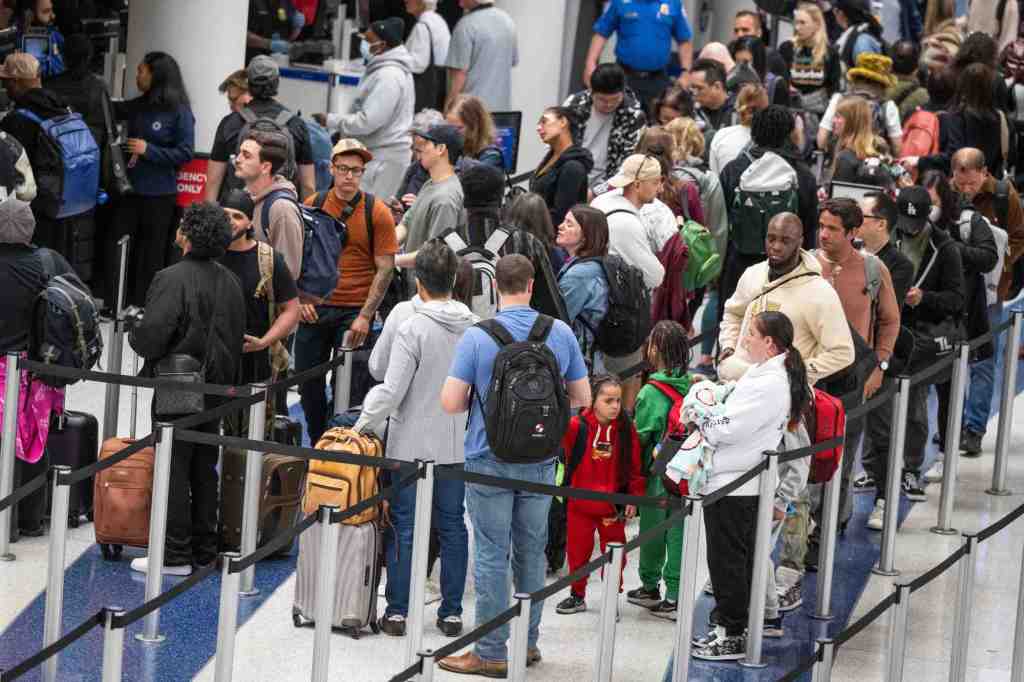What will airports look like beginning Wednesday, May 7, when the Transportation Security Administration starts demanding adult passengers flash federally accepted identification to jump aboard domestic flights?
That’s unclear.
“It’s hard to tell how it’s actually going to play out,” said Steve Lambert, a spokesperson for Ontario International Airport, who suggested travelers treat the immediate future like holiday season, arriving at the airport a few hours before their flights to accommodate any potential delay.

“We do not anticipate significant impacts on wait times,” said AnnaSophia Servin, a spokesperson for John Wayne Airport. “However, we encourage all travelers to check their IDs well before their flights. … We recommend that travelers arrive earlier than usual.”
For years, state and federal officials have pressed for adults to get Real IDs, the most popular remedy, seemingly increasing the push in recent months. The date for when special ID would be required was pushed back a couple of times — but finally, that date is here.
More than 18.6 million Californians are ready, having bumped up their driver’s license or state-issued ID to a Real ID, with the telling golden bear-and-star symbol on them.
It is also unclear what exactly will happen to those arriving at airports without the proper ID.
Lorie Dankers, a spokesperson for TSA, said those hopeful flyers could face additional security screenings or be turned away, causing potential delays for other travelers.
“I’m not going to provide an amount of time to arrive early, but the length of your delay will be determined by … people who are also not prepared for Real ID enforcement,” Dankers said. “So keep that in mind.”
All you want to know about Real ID and more
Although it can get lost in the hubbub, with all of the attention on the Real ID, there are other IDs the federal inspectors will equally accept, including:
— A U.S. passport or passport card
— A U.S. Department of Defense ID
— A permanent resident card
— A border crossing card
— A photo ID issued by a federally recognized tribal nation or American Indian tribe
— A passport issued by a foreign government
A full list of acceptable forms of ID can be found on TSA’s website.
Besides flights within the United States (international flights often require a passport), some federal buildings and nuclear power plants will require a federally accepted form of identification as well.
The push to upgrade what ID is needed for boarding domestic flights and entering some buildings was born in the U.S. Congress in 2005 to increase security after the 9/11 attacks.
On Friday, May 2, travelers collecting their bags at John Wayne Airport were greeted by the recorded voice of Secretary of Homeland Security Kristi Noem, reminding travelers to get their Real IDs: “Please do your part to protect our country.” Screens sprinkled about the airport reinforced the message — they flashed photos and videos encouraging travelers to upgrade their driver’s licenses.
“I think it makes the U.S. safer,” said Chuck Howell, an Orange County resident who was in baggage claim. “If you’re against it, there’s something wrong.”
“I don’t see the need, personally, but I don’t feel super strong about it,” said Illinois social worker Milo Hawthorne, 27, who was passing through JWA. “I think it’ll put up more barriers to people who don’t need more barriers.”
Friday found Robert Davis, a 35-year-old network engineer from Northern California, up the coast at Los Angeles International Airport. He said the switch to federally accepted ID will help reduce the use of copied or fraudulent documents and ultimately make airport security more efficient.

Rather than wade through a crowded Department of Motor Vehicles office, he opted for a passport card back in 2019.
“The first month will probably have people being turned away,” Davis said.
Theo Strehlo, a systems engineer from Kern County with the Navy, was passing through LAX as well. He supports the new push for security, but says it will come at a cost.
“There could be extra congestion from people that didn’t get it,” he said. “I think within six months, it’ll be no different.”
In recent weeks, the California DMV began extending hours at some offices for people to get a Real ID. But now the agency is pumping the brakes a bit for those who have other options. On Friday, its website trumpeted: “USE YOUR PASSPORT NOW — GET A REAL ID LATER … when (the) driver’s license is due for renewal.”
The major advantage of a Real ID is the convenience for travelers.
Getting a Real ID in California, a process that can be started online, does require an office visit and documents:
— Proof of identity, such as a passport or a birth certificate
— Two documents showing proof of residency, such as a bank statement or a utility bill
— Proof of a Social Security number, in most cases

Dankers, the TSA official, cautioned against trying to rush into a DMV office if a federally accepted ID isn’t an immediate need, because it might be tough to get appointments.
“They’re going to probably open up after enforcement again,” she said. “So look at when your travel plans are, and try to get a Real ID-compliant document prior to that.”

Most American adults are already poised to fly — and to enter the secured federal buildings and even nuclear power plants.
So far, Dankers said, more than 80% of adults across the nation have a Real ID.
Minors don’t need one to fly domestically, but they must be accompanied by someone who has a Real ID or another acceptable form of identification.
Originally Published:



